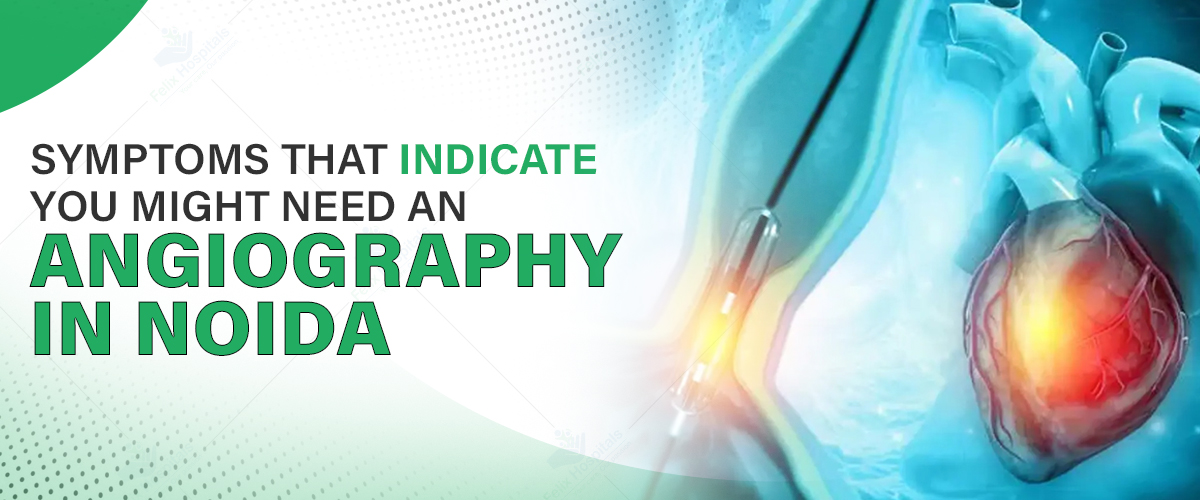
Subscribe to our

Sometimes, you experience a little pressure in the chest, getting out of breath quicker than usual, even feeling lightheaded now and then. While some people may dismiss such discomfort as heartburn or stress, it might actually be early signs of an underlying heart condition that demands medical attention. One diagnostic procedure that can reveal what’s going on inside your arteries is angiography. It helps your cardiologist to know if there’s any blockage or narrowing.
Through this blog, let’s understand coronary angiography, symptoms that indicate you might need an angiography, and how it helps to make informed choices about your heart health.
Angiography, also known as an angiogram, is a scan that allows doctors to see how blood moves through your arteries supplying blood to your heart, brain, and other vital organs. At Felix Hospital, our best cardiologist for Angiography test, will put a very thin tube (called a catheter) into your artery, usually near the wrist or upper thigh. Then they push a dye through it, which shows up on an X-ray, enabling the doctor to identify any issues.
Through coronary angiography, symptoms such as blockages, narrowing, or abnormalities that could disrupt blood flow and increase the risk of heart attacks or strokes can be easily detected.
At Felix Hospital, the best hospital for Angiography test, it's usually done as a day procedure, in the hospital’s catheterization lab. You’ll be asked not to eat anything for a few hours before the test. An IV line is placed, and you may receive a sedative.
After numbing the area (usually the wrist or groin), they will insert the catheter, a thin, flexible tube into the artery. A special dye is injected through the catheter into the blood vessels.
When the dye goes in, you might feel a warm flush for a few seconds. The specialist takes a series of images, then removes the tube. A nurse applies pressure to prevent bleeding. You’ll rest for a few hours, then go home the same day, unless our best cardiologist for Angiography test suspects something serious, and the team decides to treat it immediately.
The procedure generally takes 30 minutes to an hour.
Angiography may be recommend when your cardiologist suspects certain conditions, such as:
● Coronary artery disease
● Peripheral artery disease (PAD)
● Carotid artery narrowing (in the neck)
● Aneurysms
● Congenital heart defects
For coronary angiography, symptoms or signs listed below don’t always mean something’s wrong, but when persistent, they shouldn’t be ignored. These include:
● Chest Pressure, Pain or Discomfort: It doesn’t have to be sharp, stabbing pain. A heavy feeling, squeezing, or burning in the chest, especially during an activity can be a red flag.
● Shortness of Breath: If you’re gasping for air after a light walk, or even at rest, something could be off with your heart’s blood supply.
● Fatigue: Feeling tired all the time, that too without a reason can be your heart saying it’s struggling to deliver enough oxygen.
● Pain in Jaw, Neck, Arm, or Back: Radiating pain, especially on the left side, could be a sign of a blocked artery.
● Dizziness: Random dizziness might mean not enough blood is reaching the brain. It should be evaluated by a specialist.
● Irregular Heartbeats or Palpitations: If your heart feels like it’s skipping beats or fluttering often, especially with other symptoms, speak to a doctor.
● Swollen Ankles or Feet: This could mean fluid is building up because the heart isn’t pumping as it should.
Over time, cholesterol sticks to artery walls, which builds up slowly and narrows the space inside, a condition called atherosclerosis. Eventually, blood has to squeeze through smaller and smaller gaps. This raises your risk of developing blocked arteries.
● High blood pressure
● High cholesterol
● Smoking
● Diabetes
● Obesity
● Sedentary Lifestyle
● Genes, especially if your parents had heart problems
While some risk factors (like age and genetics) can’t be controlled, you can still take meaningful steps to protect your heart and avoid the need for invasive tests like angiography:
● Maintain a heart-healthy diet (low in saturated fats and salt)
● Exercise regularly
● Quit smoking
● Manage stress
● Control blood sugar and cholesterol levels
● Go for regular check-ups, especially after 40 or if you have a family history
Angiography helps to catch serious heart and blood vessel problems before they become emergencies. The key is to pay attention to your body.
At Felix Hospital, the best hospital for angiography test in Noida, we have a team of highly experienced, dedicated and renowned cardiologists who work in close coordination to provide comprehensive cardiac care to patients suffering from various heart ailments. They perform heart surgeries both on adults and children.
Delaying timely treatment for a heart condition can put a life at risk. For accurate diagnosis or treatment, or to confirm our angiography test cost in Noida, contact us!
Q: Does angiography hurt?
Ans: You might feel a little discomfort but the test doesn’t hurt. Also, the dye might cause a warm flush. But overall, it’s not painful.
Q: How long is recovery after angiography?
Ans: You’ll recover after a few hours of rest. Avoid lifting anything heavy for a day or two.
Q: Can heart treatment happen at the same time while performing angiography?
Ans: Yes, if the cardiology team finds a blockage, they might go ahead and fix it by placing a stent then and there.